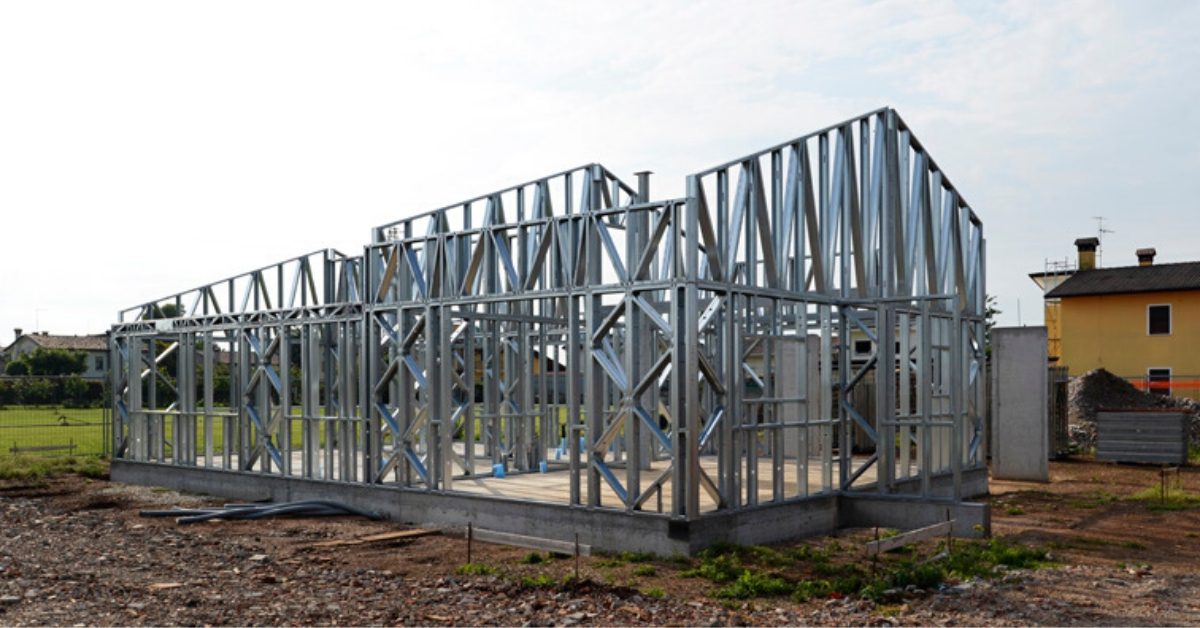Steel and cement are two of the structural materials that are most used in the construction sector.
Their diffusion around the world and transversally to the type of construction is due to the intrinsic qualities of these two materials, the use of each one of which presents a series of pros and cons.
Reinforced concrete
Reinforced cement concrete is made from the union of two materials, concrete and steel.
Steel is represented by circular section bars, which are arranged in accordance with a precise scheme and are then immersed by the concrete cast inside the formworks, which determine the structure’s geometry.
Reinforced concrete structures are, therefore, formed by a stone matrix, or cast, and linear steel elements. The matrix is obtained with mixtures of natural or artificial inerts, mixed with cement, water and possible additives.
Once placed, the mixture requires 12/24 hours to solidify superficially and months, or even years, to mature.
Reinforced concrete is used a lot thanks to its resistance to compression. Steel is added to endow the reinforced cement with the tensile strength and ductility that are typical of this metal.
The pairing results in a material that guarantees good performance in various stress states. This technology is also used for the construction of complex buildings and frames for large works.
Steel
Steel has always been closely linked to the world of construction. The use of this metal has been marked by the technological progresses that improved the production process and the material’s quality, resulting in its being used increasingly often.
Steel is an alloy composed mainly of iron and carbon. There are many types on the market, with various characteristics that depend on the composition, the production process, use.
Steel alloy has a high tensile and flexural strength, resistance to torsion and shear strength and is practically non-combustible. It is also resistant to corrosion.
It has a high resistance/weight ratio which makes it possible to build light structures, with intrinsic advantages, for example low sensitivity to seismic vibrations.
Despite the contraction of the construction market in the years following the economic crisis, the share of the market pertaining to steel structures has increased (source: Fondazione Promozione Acciaio [Foundation for the Promotion of Steel], Investigation on the use of materials in the non-residential construction market in Italy, analysis of the diffusion of steel products - trends of the last ten years and future developments of the real estate market - Fondazione Promozione Acciaio, November 2015), due to the perception of the opportunities provided by the material and the dry construction method.
Cement and steel: a direct comparison
The modern construction sector is called upon to contribute towards reducing CO2 emissions and the environmental impact of construction, both in the design phase and during the use or decommissioning of buildings.
The logic of economic cost, although important, cannot be the only aspect to be taken into account in the choice of structural materials and, consequently, of the construction technique.
Safety
Buildings with a steel load-bearing structure are light and ductile. The ductility of this alloy guarantees the absorption of seismic energy, thanks to steel’s high plastic reserves.
Moreover, steel has a lower seismic mass than reinforced concrete. Following the vibration caused during an earthquake, horizontal inertia forces are created inside a building, which are proportional to its mass: the larger the mass, the higher the risk of oscillation. A light structure is subject to lower inertia forces than one with a larger mass.
Sustainability
Environmental sustainability is an unavoidable aspect also - and especially - of the construction sector. It is understood as more than energy efficiency, a parameter that is now well-known and specified in various legislations for new constructions and energy requalification.
Steel is a recyclable material that can be 100% recovered. This property - the ability of potentially being reused infinitely - is indicated with the term “up-cycling” which indicates that, by recycling, it is possible to obtain a material with the same properties as the original material.
At the end of its useful life, cement can be fully recycled. However, for reasons that pertain to process management and convenience, inert waste is destined to be crushed for reuse in filling operations and the production of screeds and substrates. All these operations downgrade the waste and are known as “down-cycling”.
Decommissioning
Project components, such as beams or pillars, and the entire steel structure itself can be disassembled and reassembled in a different location, without requiring modifications or the creation of waste.
This is possible in cases of careful design and when the disassembly and assembly process has been taken into account from the first design phases.
Cement buildings, as has been mentioned, cannot be disassembled and reused, but only recycled for lower quality and functionality uses, having been subjected to a breakdown or demolition process.
Durability
Structures in reinforced concrete are vulnerable to external elements. Their degradation is countered by using a concrete composition that conforms to environmental aggression and by planning the correct maintenance of buildings.
Steel is chemically rather invulnerable to external elements. Its durability benefits from the fact that the structures are produced in accordance with an industrial process that is subject to strict controls. In this way, the risk of steel defects that may result in the structure being damaged from its interaction with the environment is reduced.
Specifically, to counter the risk of oxidation, steel is treated with galvanising processes or processes for the application of protective varnishes, in accordance with how aggressive the environment is.
Building technique
Construction technology plays a crucial role with regard to the time in which a building can be built.
The layered dry construction system, combined with steel structures, enables quick and precise onsite laying. Less lifting equipment is required, which costs less and takes up less space. The worksite is cleaner and safer.
The traditional wet building system foresees much longer construction and maturation times, the use of more lifting equipment and a higher risk of unforeseeable events at the worksite.
Quality and precision
The dry construction process guarantees higher precision and correspondence between the design and construction phases. Industrialised and engineered components, in fact, are designed with details down to the millimetre and are assembled onsite.
Conversely, reinforced concrete constructions, although they are subject to structural calculations and design, are subject to the variability of onsite laying, which can cause differentiation between the design and the works built.


